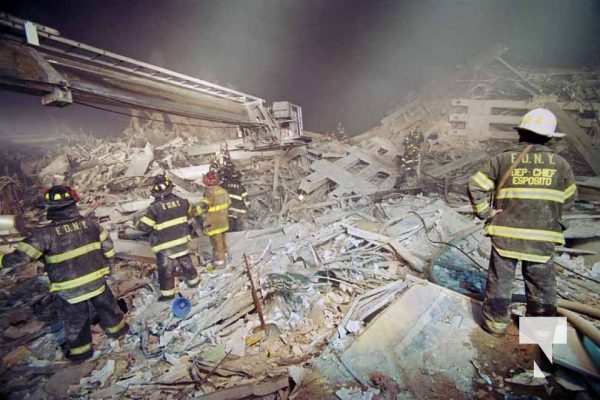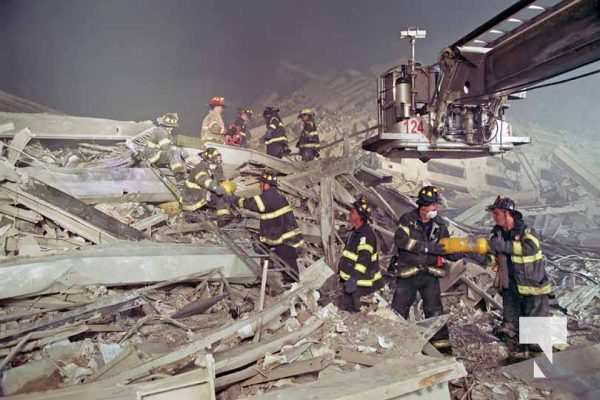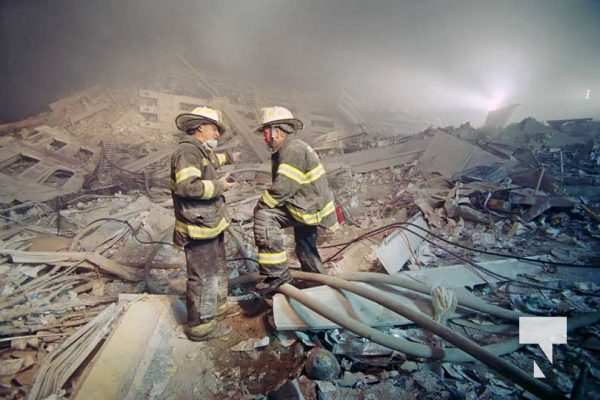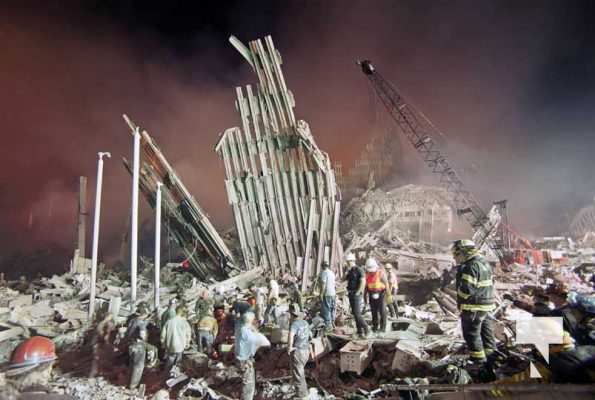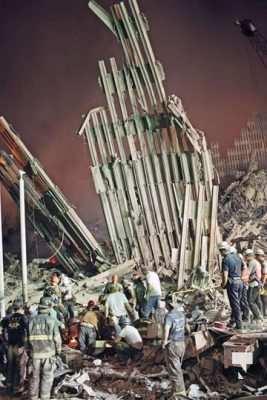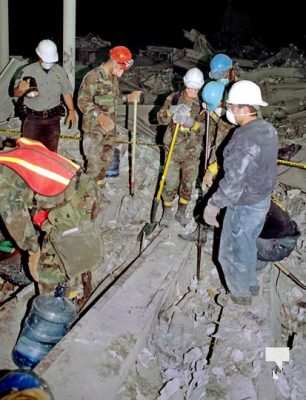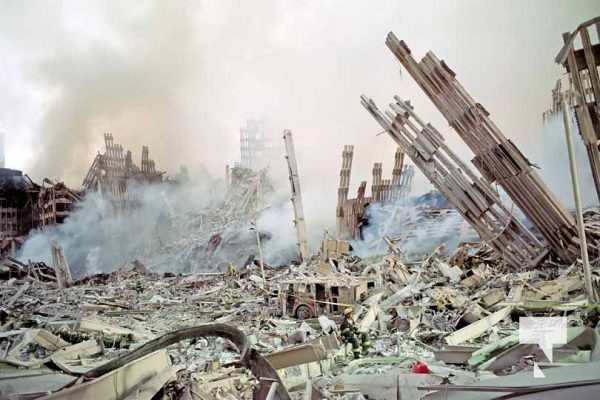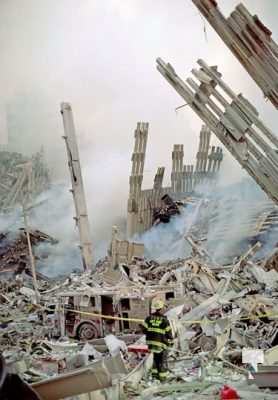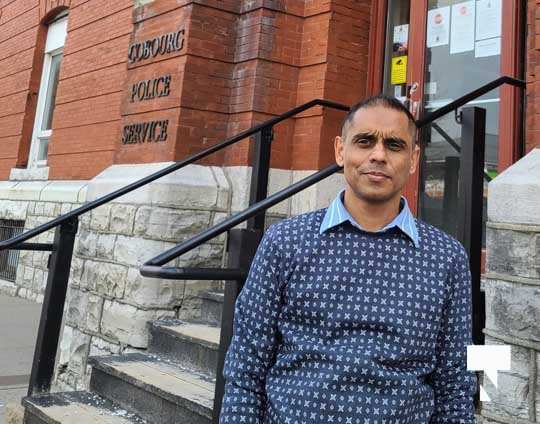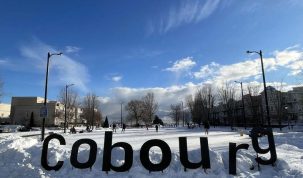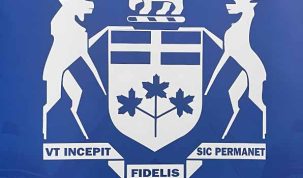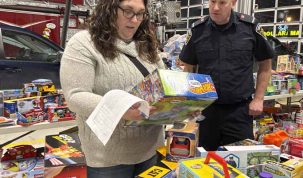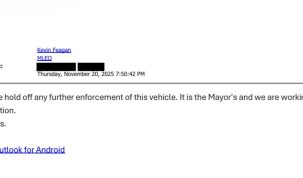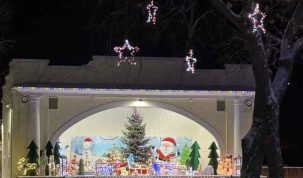Where were you?
September 11, 2001 is one of the very few days in our lifetime where you will remember where you were when you first heard about the attacks.
For those that were old enough to remember – the world changed on that day.
Not only was the United States attacked, but freedom was attacked.
People that died that day were from all parts of the world including Canada.
That’s why I’ve always stated it was an attack on Canada as well.
It didn’t have to be on our soil, to know that we were attacked.
Twenty years later we remember.
Mike Heller is head of 911pictures.com and lives just outside New York City.
I’ve never met him personally, but known him for many years through his stock photo agency.
Heller was asked to document the attack on the World Trade Centers just hours after it happened.
Today’s Northumberland is extremely grateful for Heller and 911pictures.com for allowing us to use a number of images he took that day from Ground Zero.
John Saunders was teaching CPR training at Ryerson University on September 11, 2001.
He was unaware of what was happening until driving in downtown Toronto later that morning.
The streets were nearly empty. People were glued to their televisions listening, watching for what was happening in the world.
Two stories, from two different people.
Each sharing their thoughts and experiences on the day the world changed.
Let us never forget.
Michael Heller
“The eye of man hath not heard, the ear of man hath not seen, man’s hand is not able to taste, his tongue to conceive, nor his heart to report, what my dream was.” William Shakespeare
I am in a dream; I must be dreaming. I know this because where I am standing, and what stands before me, cannot be real.
My sense of reality became questionable at 9 o’clock this morning, with horrible televised images that seemed impossible, that made no sense.
Time slowed down, and began to bend.
At 8 o’clock this evening, reality became warped further with a telephone call and the anxious voice of the New York State Fire Administrator:
“We need you there.”
Suddenly I am traveling through the dark at high speed down a deserted eight-lane highway.
Then a roadblock appears – flashing lightbars, flashlights in my face: “You may proceed.” More checkpoints, cops with worried looks, confusion: “Move! Move!”
Now I am on foot, walking past a line of ambulances interspersed with TV satellite trucks.
Near the hard glare of a spotlight, a news correspondent – microphone in hand – watches me as I walk past.
She has a frightened look on her face.
In the real world, journalists aren’t supposed to be scared.
What world is this?
I reach my destination, later to be known as Ground Zero, and find out exactly where I am:
This is the world of the unfathomable and the surreal, and nothing – nothing – will ever be the same again.
In this new world, it is 11:00 p.m. on Tuesday, September 11th, 2001, and I am standing on the corner of West Drive and Vecsey Street in lower Manhattan.
Three hours ago I was safe and sound, sitting on my living room couch. Now I am standing ankle-deep in mud, wearing a respirator, surrounded on all sides by complete destruction.
I find myself rooted to this spot, staring – not knowing how or where to proceed, what to do, or even what to think. It’s all happening too fast, too different, too much.
“Slow down, Michael,” I tell myself, remembering my training: Stop, take some time, look around, think, formulate a plan. I remind myself that I am here because I was summoned by the New York State Office of Fire Prevention and Control, at the request of State Fire Administrator Jim Burns, to use my photographic skills to document the scene and the rescue efforts as I see them. I must capture as much of it as I can, so that others someday will have an idea of what it was like to be here.
I decide to follow the traditional approach of any emergency scene, and do a “size-up” by walking the perimeter of the site.
Looking west towards the Hudson River, I see that the buildings continue from West Drive all the way to the water, so a full circuit of the perimeter is impossible.
Forced to go in only one direction, I head east on Barclay Street.
I am barely a quarter of the way down the block when I slowly come to a halt again, once more in awe.
To my right rises a 10-story high pile of debris, what used to be No. 7 World Trade Center.
I remember from the newscasts that this was the third building to fall, at roughly 5 p.m. this evening, after being engulfed in fire after the two towers collapsed. It is still burning in there somewhere; thick clouds of smoke billow out from inside the rubble as two FDNY tower ladders use hose streams to extinguish the fire – an effort that I know will take hours, if not days.
It is not the building’s ruins that cause me to stop, however. What freezes me is the scene around it. More than any broadcast scene of rescuers sifting through rubble, what I see before me at this moment tells the true story of the World Trade Center disaster.
On this side street, away from the commotion of the Command Post, rescuers move silently through a two-inch-deep layer of dust.
Like a winter’s eve snowfall, it coats all the vehicle parked on the street.
Coated too are the sides of all the buildings surrounding me, save for hundreds of jagged black holes where windows were blown in from the force of the explosion.
There is no more “street” and “sidewalk”; there now exists only a field of twisted pieces of sheet metal, paper, plastic and steel, spread around me as far as I can see.
Scene lights and red rotating beacons atop apparatus provide the only light, illuminating the dust still blowing through this eerie landscape. It is quiet here – no one is saying much. A firefighter passes by. We look at each other, but there is nothing to say.
I pick my way slowly over to something that has caught my eye, about halfway down the block. It is a piece of steel girder, perhaps 25 feet long and three feet thick. It is hard at first to realize that it is a girder, because it stands as tall as I am, and it has been bent into the shape of a pretzel.
My God. Unable to continue down Barclay Street due to the wreckage strewn everywhere, I turn north onto Greenwich Street.
There, covered with layers of dust and paper and lit by the harsh glow of scene lights, sit several NYPD patrol cars, belonging to the 17th Precinct just down the street.
A makeshift camp has been set up in the shadows on the sidewalk in front of them – some office chairs, a small table and a couch have been dragged onto the sidewalk from a gaping hole in the side of the office building there.
Several weary-looking firefighters are sitting or lying down there, listening to a small beat-up radio that’s tuned in to a local news station.
I find it ironic that we should be sitting a block away from devastation, listening to news about it.
A firefighter offers me a small folding cot that is there: “Come lie down if you’re tired.” Part of me wants very much to sit and be with them – to talk with them, to try to understand. And yet, another part of me is reluctant. Even though I am a firefighter, I am not a New York City firefighter, and I am both honored and awed to be in their presence after what they have seen and experienced and lost.
I thank him, politely decline, and move on.
From Greenwich Street I turn east again onto Park Place, then south onto West Broadway, skirting the wreckage of No. 7. I make a right onto Church Street, and begin walking back south towards the World Trade Center proper.
I reach the intersection of Church and Dey Streets and look southwest, where the south tower used to be. Before me is the remains of No. 4 World Trade Center. The right half of the building still stands, its façade shredded and blackened, but the left half has been destroyed by pieces of the south tower, which now tilt up to the sky at crazy angles. Lit from behind, and seen through a mist of smoke, ash and dust, it is a silhouette of destruction. On three flagpoles in front of the remains, scorched and tattered flags still sway in the soft breeze.
I move on, through small streams of hoseline runoff and mud, until I come to a more brightly lit area at the corner of Church and Liberty Streets.
There is more activity here. A large crane has been set up, and a crew of 20 or so ironworkers have set themselves to work on a large pile of girders, using cutting torches to hack them into lengths that the crane can manage. It is agonizingly slow ands dangerous work. Each girder is at least 100 feet long, and it takes several minutes to make a single cut through a section. As I watch, someone yells out, and I look to see that a crane hook has narrowly missed me as it swings past. It’s time to move on.
I turn west onto Liberty Street – aptly named under the circumstances, I think to myself – and make my way down to where some apparatus are operating. FDNY Tower Ladder 124 is extended out over the wreckage, and a group of firefighters have formed a human chain underneath it, passing ladders, tools and equipment bucket-brigade style back out to the truck.
Beyond the extended tower rises a small mound of debris and steel, then nothing but blackness. I am told that the blackness beyond the rise is “the Pit,” the stories-deep hole left in the plaza area when the towers collapsed, and that this crew was just returning from a search-and-recovery foray into the pit. Judging by the looks on their faces, I conclude that it has not been very successful.
I continue west down Liberty Street, back into the darkness and quiet. As I reach Washington Street, I come to what I think is a dead end, a huge pile of girders and sheet metal blocking the street. As I pause to consider my options, a flashlight suddenly appears from the other side of the pile, flickering through the dust. A few moments later an EMS worker in full hospital scrubs comes towards me, clambering over an opening in the pile. I watch carefully where he goes, then retrace his steps through the small passage.
It is not without apprehension that I do this. The pile is about 20 feet high, made of steel I-beams, bent pieces of rebar, sheet metal and countless smaller pieces of debris, all piled at crazy angles and all of it covered with a thick layer of dust and ash. It is pitch-black here – I have only the beam of my flashlight to guide my way – and the footing is treacherous, due to the combination of ash and dust on slippery sheet-metal surfaces.
Because nothing is level, each step is a search for the next solid, useable piece to put my other foot, and I am hesitant to grab hold of anything to increase my stability, lest I upset some delicate balance within the multi-ton pile of steel pickup-sticks.
Doing a balancing act of my own, I successfully make it through to the other side, only to find myself standing shin-deep in a puddle of mud and water, which has been caused by a steady rain of wind-blown spray coming from somewhere above me.
Looking west down Cedar Street, I see a silhouette of an FDNY engine operating, and the entire street is awash in a fine spray of water. Looking up, I see three hose streams shooting rom the 14th floor of one building into next – fires are still burning, and there is a reason they’re fighting the fire from the adjacent building and not from within: This is not over yet. Nothing is safe.
Deterred by the falling spray – and for the sake of my camera equipment – I continue on Washington past Cedar Street to Albany Street, and then turn right to make my way west on Albany, back to West Drive. It is now about 2:00 a.m. on the morning of the 12th, and I have made my way roughly three-quarters of the way around the perimeter of the collapse. I am back on West Drive, looking north. Above me, in a building of questionable stability, flames shoot out a window. From the window of an adjacent building, a firefighter calls out, “More pressure!”
In front of me, FDNY Ladder 113 sits abandoned and stripped of all tools, the front half of the rig nothing but a scorched shell. The South Walkway, an enclosed foot bridge that ran between the World Trade Center and the World Financial Center, still stands, but the stairway at the end now leads to a metal-strewn field of debris, from which small spot fires flicker in the dark. Columns of smoke still rise in the distance. It takes an hour for me to work my way slowly down the median strip of West Drive, past burned-out cars and crushed ambulances, to a point where I can try to cross over the northbound lane – but here, West Drive has become a lake three feet deep, so I am forced to retrace my steps back to the Albany Street intersection and continue up the southbound lane. The passage is easier here, and I make my way north, toward Ground Zero.
I reach the northwest corner of West Drive and Liberty Street, and realize that I’m becoming a little cold and very tired. I have been up for almost 20 hours, and my initial adrenaline rush is starting to wear off. A portable generator with a built-in scene light has been erected on the corner, and, finding nowhere else better to sit, I set myself down on the trailer-hook portion of the generator, remove my camera belt and helmet, sit back and try to gather my thoughts for a moment.
A full two hours later, I am still sitting there.
Thoughts (and pieces of thoughts) come all in a rush, each trying to find its way into some sort of pattern that makes sense of what I have seen.
In a brief moment of clarity, I realize that the scale of what is before me is immeasurable. It goes on and on – and yet, as I look down, something small catches my eye.
Near my boot I see a piece of paper, a portion of a ledger book, burned around the edges, with a handwritten note on it.
This paper was a small part of someone’s world; he or she held it in their hands. That person was real…once had existed…had family, friends, lovers…and feelings.
I let the ledger page fall, and watch it drift back to its resting place.
I reach down and slowly run my fingers through the layers of dust and ash at my feet. It has a soft, powdery texture, almost like talcum powder.
I let some of the dust fall from my hand, and it blows away in the soft breeze.
Some time later, I am joined by some FDNY firefighters who have been assigned to operate Engine 210, which is parked amid a sea of mud and paper a short distance away from me.
The whole rig is covered in dust, but appears otherwise unscathed. I have not seen anyone go near it while I have been here, until now.
“Their entire company is missing,” one of the firefighters tells me quietly. As their lieutenant goes off to get further orders, they sit and wait in the remains of a battalion chief’s wrecked Suburban. We sit together for a time, not speaking.
We don’t need to.
Time again to move on.
I wish the men well, and walk north on West Drive, underneath the South Walkway, across World Financial Center Drive, to the World Financial Center building.
Here again, the sidewalk is blocked by a huge pile of debris. In order to continue north, I enter the ground floor of the building, walking into what used to be a health club.
It is an eerie sight.
The force of the collapsing towers has blown out all of the windows, and the heat from the blast has melted all of the club’s aerobic equipment, twisting it into strange, gruesome shapes. I climb out of one of the window openings onto a large girder, and see that I have finally reached the edge of the main debris field.
There is activity here. In the harsh glare of scene lights, at the base of a 50-foot-tall chunk or World Trade Center exoskeleton, a group of 20 or so rescuers has found a body. Several FDNY firefighters, along with some steelworkers and a group of volunteer firefighters from Long Island, are trying to recover it from beneath a large steel girder. I watch them for a period of time, during which they try everything from digging underneath it to an all-out tug-of-war with a human chain of firefighters using ropes lashed to the girder.
There is an air of frustration; the beam is so large and so buried that even after several attempts at “One…two…three…HEAVE!!” it hasn’t moved even an inch.
A rescue foreman climbs over to where they are working.
“Look, guys, this isn’t working. We gotta move on.”
“No, wait!” they protest. “We can get her out! We almost have her!”
“Guys, I know how much you want this, but this is taking too much time. We gotta keep looking – the dogs may have found something over by the South Tower.”
“No, wait, please – we can do this!”
“I’m sorry, guys – we can get her as soon as we can get a crane in.”
The team lingers, and then reluctantly moves away. Those of us remaining stand in silence, rooted by the sight of a single slender female arm emerging from beneath that huge piece of steel. Dawn comes to Ground Zero.
The sky begins to grow brighter to the east, and a tableau of destruction slowly appears before me. Amid billowing clouds of smoke, huge 100-foot pieces of the towers jut out of the ground at odd angles, where they were embedded after smashing down with forces that I cannot even begin to comprehend. I feel like I have traveled back in time to World War II, to Dresden, Germany, after the massive firebombing that took place there. Then I realize that it is more like the movie The Day After, which imagined America after a thermonuclear war. This is the Day After, and I must document it. I begin to make my way back around the perimeter, back toward the way I came.
I trudge south along West Drive, past overturned vehicles and firefighters who are sleeping the best they can amid piles of equipment and debris. Then past 210 Engine, to an area just beyond where National Guard troops have located what appears to be part of another body. I watch as they use some bits of found debris to very carefully brush away surrounding dust and papers, while another guardsman lays out a body bag next to it. In the background, smoke rises from something burning in the rubble.
Gotta keep moving…. Back up Albany Street, to Washington, then onto Liberty Street again. 124 Truck is still there, but for the moment there is no work going on. Firefighters sit and wait in silence.
I turn north onto Church Street, which has become very busy.
With the light of day has come a renewed rescue-and-recovery effort, and between the two buildings of No. 4 and No. 5 World Trade Center, several hundred people are working to remove debris.
Walking among them, I see that they represent every possible embodiment of public safety-related profession that you could conceive of: FDNY, FDNY EMS, NYPD, Port Authority Police, Transit Police, Housing Authority Police, FBI, DEC, ATF, OEM, DOT, NYC Public Works, ironworkers, plus numerous others – all working together, side-by-side, as one. I am impressed to the point that I put down my camera gear and pitch in, pulling a piece of scrap metal out of the way there.
We move quickly but carefully, pausing only when we encounter a piece of steel too large for us to move. A K-12 saw is brought in, and sparks fly.
There is not much more I can do here for a while, so I pick up my gear and begin to move on.
As I leave, I see that a makeshift infirmary has been set up by local hospital workers and Red Cross volunteers, near where everyone is working.
As I pass by, I am grabbed by the arm by a woman in surgical scrubs. “Let me see your eyes!” she says, as she turns me so that she can look directly into them, her face inches from mine.
After a moment, I am allowed to continue, but not before noticing several other rescue workers seated nearby who did not pass the test, who are forced to have their eyes irrigated with a saline solution – whether they want to or not. More destruction.
On Church Street, FDNY Ladder 9 sits in ruins, its windows smashed, covered in dust and chunks of concrete. On Vecsey Street, between the shell of No. 5 World Trade Center and the Post Office building, an unknown FDNY engine sits on the pavement, its wheels melted, the truck body burned beyond the point of recognition. A 1-3/4” hose line is still attached to one of its discharges.
At the intersection of Greenwich and Barclay Streets, the heavy equipment has begun to move in. A tower ladder is still operating there, directing a master stream onto the enormous smoldering pile of No. 7 World Trade Center. The street needs to be cleared, so piece by piece a payloader begins the process of loading up a nearby dump truck.
Down a side street, 50 more dump trucks are waiting to take its place, I know that before they are done, they will need 50 times again more.
Exhausted. Aching. Numb. I have been carrying a full load of bunker gear, cameras and lenses for 16 hours now. I have become tired to the point that, as muscles give out and reaction times slow, I will be in danger if I continue here much longer. Juggling feelings of both disappointment and relief, I begin the long walk back to my car.
After a few blocks I reach a police barricade, pressed up against which are dozens of journalists, TV crews and curious onlookers with cameras. Suddenly, because I’m emerging from an area where relatively few people are permitted (and because my turnout gear is caked with dust and mud), I am the focus of a swarm of TV cameras, still cameras, and reporters with notepads and an endless supply of questions: “What’s it like in there?” “Have they found anyone alive?” “Did you see any bodies?” and “What was your name again?”
I do the best I can. After a while, a National Guard Hummer comes down the street towards us with a guardsman manning a machine gun on the roof. This causes quite a stir among the journalists, and they all run off to investigate.
I realize how uncomfortable I felt about being interviewed.
They should have talked to one of the firefighters who had spent desperate hours digging in the pit for his brother firefighters and fellow man, hoping against hope to find someone still alive. In this strange and horrible world I have just come from, their love for one another was the only thing that kept shining on, the only thing to me that was truly real. I drive up West Drive, away from the scene, and pass throngs of New Yorkers holding up signs: “Thank You, Firefighters – You Are Our Heroes!”
I am a firefighter, but am I a hero? No, only a man – the “glory and shame of the universe,” as philosopher Pascal once said. I’m merely a human being, just trying to help. We are all only human, but it is our humanity that makes us special.
I drive onward, towards home.
John Saunders
It wasn’t a case of “if” John Saunders would go to New York city on September 11, 2001, it was a question of how.
Saunders has 30-years of emergency related experience worldwide including serving seven-years as Provincial Director in Disaster Management and International Response for the Canadian Red Cross, was involved in SARS, several American hurricanes, tornadoes, the 2004 tsunami and multiple floods.
He’s been deployed to the 2010 earthquake in Haiti previously and went back later to establish a mobile field hospital in response to the cholera outbreak.
Saunders now lives in Port Hope and spoke exclusively to Today’s Northumberland about the events of 9/11.
On September 11, 2001 Saunders was teaching a CPR course at Ryerson University in Toronto during the morning.
When America was attacked, first with the north tower of the World Trade Center at 8:46 a.m., then seventeen minutes later at 9:03 a.m. with the south tower, then with the aircraft crashing into the Pentagon and the last crash at 10:03 a.m. when the passengers attempted to regain control of an aircraft when it crashed into a field near Shanksville, Pennsylvania, Saunders and the students were oblivious to what was happening.
“I drove through the ghost town, which was downtown Toronto and I turned on the news and found out.”
Immediately Saunders went home and packed and headed to New York to help in anyway he could.
“Unfortunately (at the border) I made the mistake of saying I was actually going to New York City, they basically turned me around and said, “we don’t need your help.”
But it wasn’t a case of if he was going to go down to New York city it was a case of how he would help.
“I’ve been responding to disasters my entire career,” said Saunders sitting in the backyard of his Port Hope home.
“It was just something I had to do. I knew that there was people hurting, suffering and I needed to go.”
Living in the States for several years, it impacted him “deeply.”
Approximately three days later he went across the border and hooked up with a number of firefighters from Massachusetts and arrived in New York City and the “pile” as it would become known five days after the attack.
It was on that pile that Saunders would spend the next three weeks.
Having been to New York City numerous times, Saunders said he was initially disoriented because there wasn’t the landmarks to recognize where he was standing. The “World Trade Centre complex was unrecognizable. The pile of stuff – it was organized confusion – organized chaos.”
Saunders was assigned a role like so many others to look through the pile for human remains.
“And also to sift through for personal items.”
Both the north and south towers of the World Trade Center were each 110 stories high when they crumpled into a mass of rubble.
Saunders said he was working anywhere from street level to 200 feet high searching.
It was eerie and shocking for everyone.
“Everyone was just going through the motions because we couldn’t believe this could actually happen.”
“Planes just don’t fly into buildings.”
“So I think that shock was resonating through all the first responders until enough time had passed and then it was about the job.”
After long days of sifting through debris he was put up initially at a school, then as time passed they were put up at a hotel.
Saunders day would start off by making a call to his loved ones, meeting up with members of the team and having a cafeteria style breakfast.
They would travel to the pile and be assigned a certain grid area to search.
“Literally it could be handfuls of stuff going into a sifter and going through it. Other times it’s really manual labour where you’re picking up huge chunks of concrete.”
But all worked stopped to pay respects when a body was found.
“It was carried discretely through the path of us to the coroner’s tent.”
“After a moment of silence then we get back to work.”
Saunders said there was “regular stops” to pay respects.
“It had nothing to do if this was a firefighter, it had to do with this is a human life and it needed to be honoured and respected.”
“That didn’t stop the entire time I was there.”
Saunders said the businesses of New York were amazing to the people helping.
“They would open up a restaurant if we showed them our pass or covered in dust and they’d give us a free lunch.”
“It was their way of saying “thank you” for coming and helping.”
It was the first time Saunders thought that he was witnessing the worst and the best of humanity.
“Back then New Yorkers had the reputation of being as tough as nails, don’t mess with them type of attitude and that changed overnight.”
“We were all just human beings trying to help each other out.”
“They didn’t care if I was from Canada.”
The symbolic “pats on the back” meant so much to him and others working on the pile.
There was a sense of “oneness” throughout the city.
At times, like mostly everyone, Saunders broke down.
But it was the search and rescue dogs or cadaver dogs that helped him immensely.
“Their handlers were awesome. They let me hold the dog during a break. I’d pour water on its paws because they were burning because of the smoldering rubble.”
“They licked my face and I’m holding them and that’s when I allowed myself to break down.”
Once the break was over – both the dog and Saunders went back to work.
Like many going to most (delete) disasters – it was hard for Saunders to leave.
“It sounds trite, but when you’re saving the world it’s tough to come home. When you’re making a difference it’s tough.
When you come home it’s anti-climatic.”
Since 9/11 Saunders like many others have gone through different emotions, especially when the actual day gets closer marking another year.
“I think anyone who was there is dealing with trauma.”
But Saunders said the “CNN effect” always plays a part that anyone who watched it repeatedly on television is likely dealing with the trauma of witnessing such a horrific event.
“That’s going to have an effect on us as a society.”
Marking the 20th anniversary of the attacks, Saunders said in some ways if feels like 100 years ago some days and others it feels like yesterday.
As tragic as horrific as 9/11 was, the lessons learned have benefited emergency services both in Canada and the United States in dealing with large scale incidents.
Coordinating communications has vastly improved in emergencies as a direct result of 9/11 but adds, “there is no such thing as a perfectly managed emergency or disaster.”
“We will always be learning.”
Twenty-years after 9/11 Saunders said he looks back and says, “I love humanity, but I hate people.”
“I respect humanity. We’ve got so much potential. I’ve seen the power of humanity at work. However, there are bad people that are out to hurt – but that is a minority of the world.”
Saunders sums up the interview by stating “Like many others in the world, if there ever was another tragedy of that proportion, if something bad happens, I’ll be there.”


